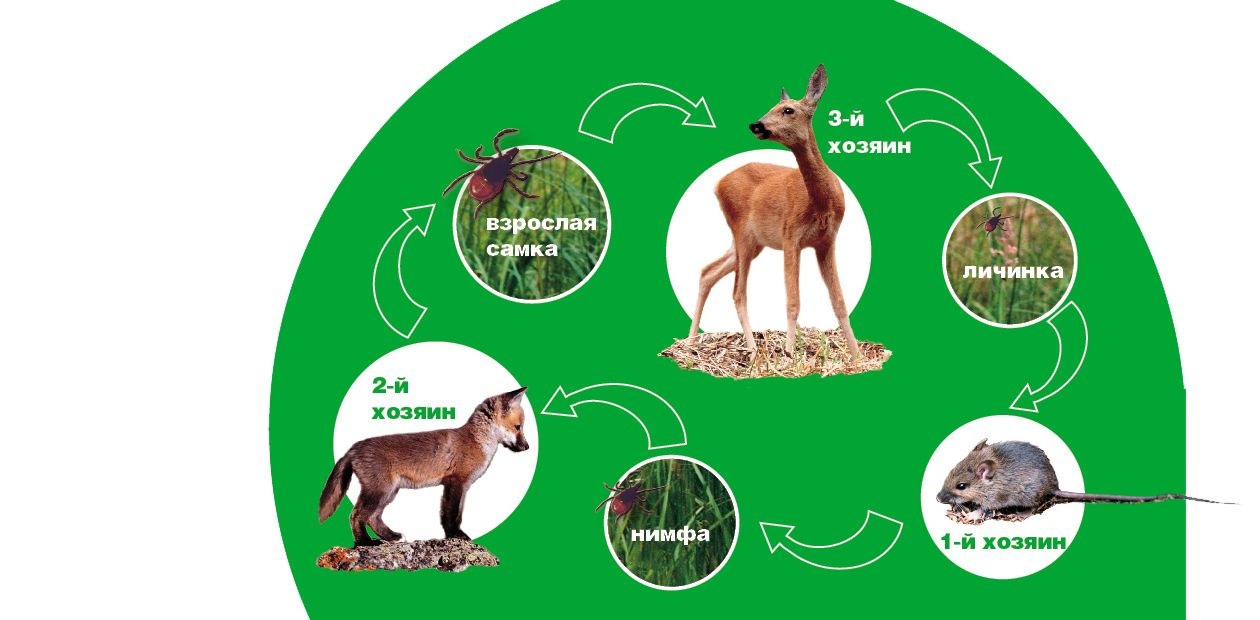Octopod Vampires
What a tiny insect: eight tenacious legs and a soft velvety body… It has clung to your clothes and is crawling all-out, “What a good prey!” If you do not look out, the little one will stick. Now troubles appear, much greater than a mere loss of several milliliters of blood. All know the danger these tiny vampires bring. However, only specialists know the details of their life and relations...
One can see from the title of this article that our “object” has four pairs of legs. Therefore, it belongs to the species Arachnida, and not to hexapod insects. Two wide groups of the order Acarina have more than 30 thousand species. Ticks, whose number of parasitic species is no less than that of insects, have a greater variety of forms.
The taiga and European forest ticks are representatives of Ixodinae, the most ancient and primitive subfamily of ixodid ticks. It is not easy to determine their “great-great-grandmothers and great-great-grandfathers” due to the lack of relevant paleontological material. At the beginning of the past century it was considered that Pro-ixodinae descended from a fossil of the Arachnida order, and reptiles were their first feeders (Schulze, 1932). Later, the origin of Ixodinae was associated with the appearance of prototheria and pouched mammals (Pomerantsev, 1938). This issue still remains open. Today one can learn how this group of animals originated at the beginning of the Cretaceous period only by studying the parasitic relations of their most primitive representatives.
From taiga to British seas…
Numerous relatives of the taiga tick live in all natural zones of the globe. However, in the Ixodes genus, which has more than 200 species, only two subgenera parasitizing on sea birds are cosmopolites. For instance, the tick Ixodes uriae, an inhabitant of nests and holes of colonial sea birds, leads a good life on the Kola Peninsula, the Barents and White sea islands, the Antarctic coast, and the shores of Australia, South America, and even Africa. Its “favorite” food is the blood of seagulls, penguins, guillemots, and other sea birds. However, if you decide to have a walk in a rookery, you should know that the I. uriae female will take advantage of this and stick to you. Although, when she gets full, she will die: for her, the blood of mammals is poison.
In one “meal” lasting more than a week a taiga tick female can increase its weight more than 100 timesZoologist V. N. Karpovich (1973) noticed the following interesting peculiarity in the behavior of this species: ticks can be found on birds only at the beginning of summer. It is likely that such behavior of Arthropoda is adaptation to the way of life of ticks’ main hosts — guillemots. At the beginning of August, the birds’ nestlings grow up. After this, they leave their homes and migrate, mostly among ice blocks, till the next spring. Therefore, ticks that attack birds at a later time have all chances to find themselves, after the meal, in another habitat that is absolutely unsuitable for them.
The widespread tick Ixodes lividus is a “hanger-on” of sand-martins. All phases of development of this tick take place in these birds’ nests: larvae, nymphs, and imagos follow in a strict order, each parasitizing on its own age group of the host. Ticks of this species have the shortest cycle of development: it lasts only a year. In comparison with it, our taiga tick is a long-liver, because in some cases it can live up to seven years.
Among Ixodinae there are species that prefer hot dry climate. Ixodes laguri is an inhabitant of deserts and steppes. It parasitizes on small mammals. This species can be found not only in plains but also at a height of up to 1.5 thousand meters above sea level. And this is not a limit: some representatives of the subgenera Scaphixodes and Ixodiopsis, inhabitants of rocky and stony biotopes, were detected at heights of up to 3.6 thousand meters above sea level!
Blood and love
At each stage of its development, an Ixodinae feeds only once. This “moderation” is compensated by the “devourment” of great blood portions, whose weight and volume is greater than those of the hungry individual by a factor of several tens and even hundreds! For instance, the taiga tick, which is characterized by the most “perfect” type of parasitism, during his “dinner time” lasting 6—10 days can increase its weight from 2 to 247.6 mg (Balashov, 1967).
It is interesting that at all phases of development (larvae, nymphs, and adults) the tick’s intestines have cells with the so-called “food reserve”. This material “memory” of successful past “meals” helps ticks survive hard times. The reserve cell elements of the intestinal epithelium, together with digestive and secretory cells, serve as storages of nutrients: the hemoglobin of the former host’s blood, proteins, fats, and carbohydrates.
And what if a tick does not get the needed portion of blood during a meal? Many species are capable of sticking again, to a new warm-blooded host. If this does not happen but the blood volume received is close to the lower limit of that needed, the female begins to lay eggs. However, gnome ticks will be hatched from these eggs.
Many people know that only females of the taiga tick (like many of its relatives) have to eat while tick males demonstrate practically absolute abstention. When taiga ticks are kept not in natural conditions for a long time, one can often see males that stick to hungry females: they replenish their moisture reserves owing to the hemolymphs of their females. This behavior of ticks is called homo-vampirism. By the way, in this case ticks can exchange various infectious agents.
The blood volume taken by the female depends directly on its “family” status: an unfertilized female stops eating and leaves the host. Meetings of males and females necessary for reproduction can take place not only on plants and soil cover, but also on the feeder: a male finds a feeding female and fixes on her with the help of his legs. The male remains in this position for several hours and even days. It is considered that the higher the number of ticks, the more frequent is their mating away from the host.
The taiga and European forest ticks are “champions” in the amount of blood they drink. They lay a record number of eggs, which can be more than 2.5 thousand. To compare, a less “skilful” vampire Ixodes trianguliceps lays only 350—500 eggs.
Hunting
Different species of Ixodinae prefer different hunting strategies. Some of them lead the whole life in the “refuge” of hosts, be it a hole or a nest. Some prefer to wait for a victim in an ambush, climbing plants, brushwood, etc.
The taiga tick, for instance, not only waits for a potential feeder, but also moves in its direction. Sometimes it crawls to a distance of up to 5 m. In the process of evolution ticks have developed some characteristic poses and motions, which help them not to miss a host.
Ten main elementary behavioral acts have been described for the taiga tick. These include the rest pose in a shelter, scanning, attack on a feeder, and even leaving to a refuge. And if a taiga tick decides to “have a rest”, neither smells nor mechanical stimulation will make it “change its mind”. If, for some reasons, a tick “gets frightened”, it takes a lurking pose, that is, it pretends to be dead, coiling up all its limbs (Filippova, 1977; Balashov, 1982; Leonovich, 2005 et al.).
Much is known about ticks today: the efforts of several generations of researchers who have been trying to unravel their mysteries were not in vain.
Nevertheless, nowadays these arthropods are still a threat to humans, although humans are a kind of ecologic “traps” for ticks. Instinctively, ticks react to humans as to any warm-blooded animal. This contact ends tragically more often for ticks than for humans.
Like all living creatures, ticks are vulnerable, and the reproductive instinct does not leave them any choice: the larger the prey, the more chances to eat their fill. At the same time, more “reasonable” humans can easily take precautions, which will spare trouble on either side.





